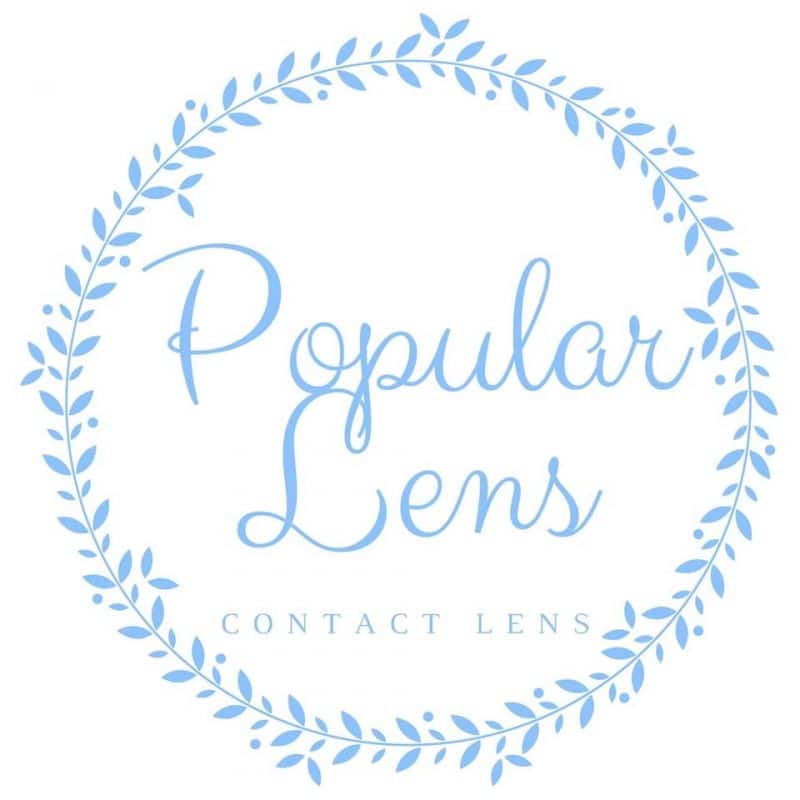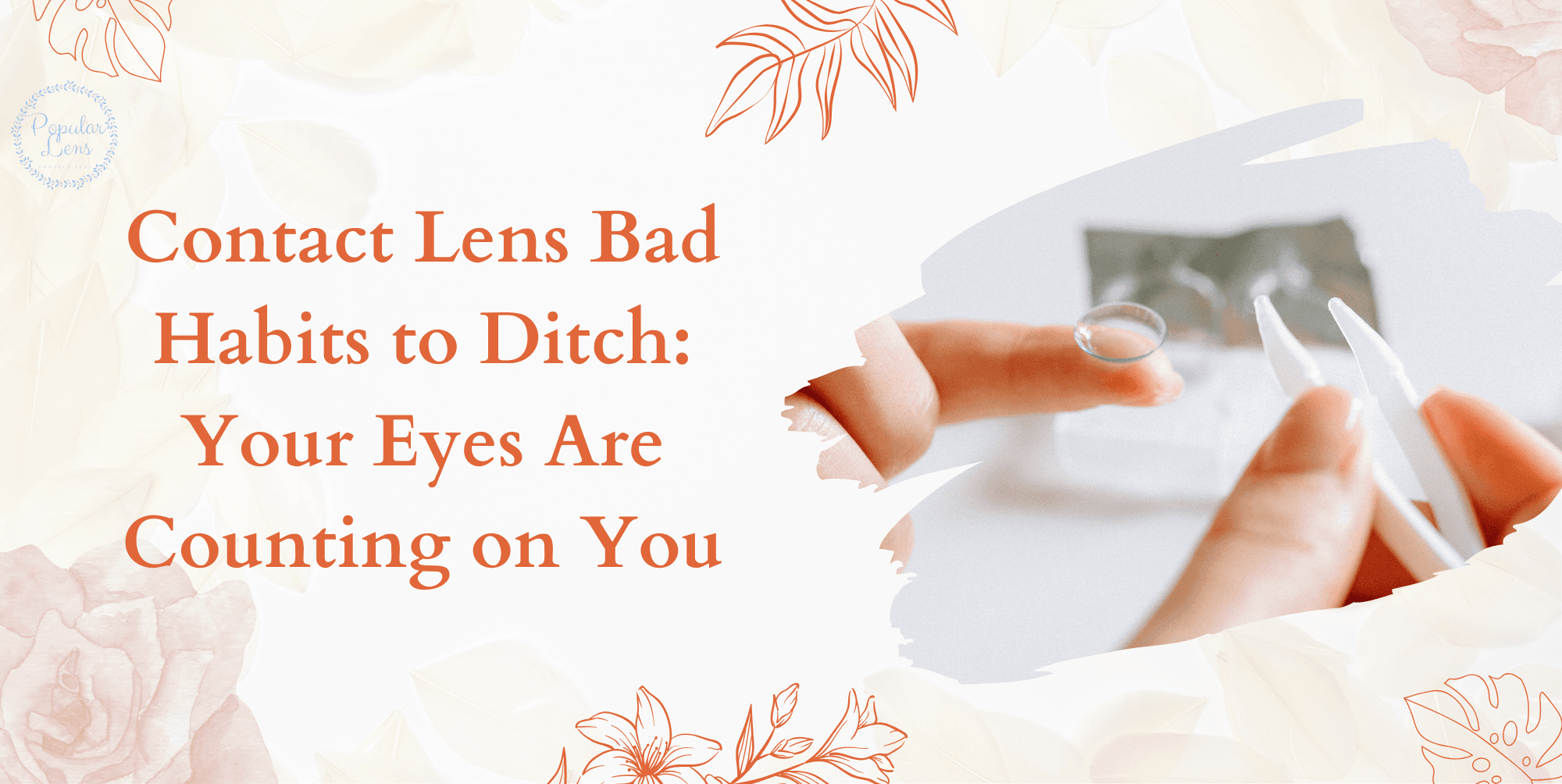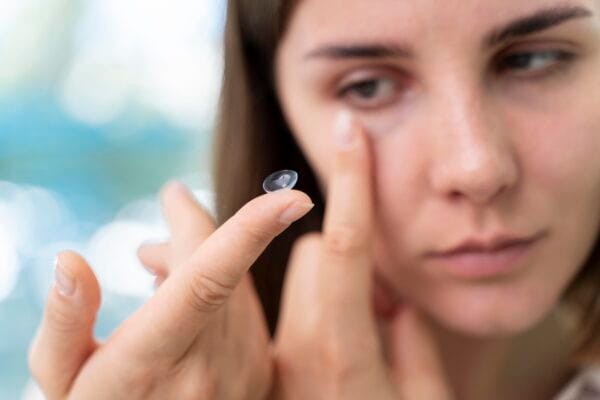Contact Lens Bad Habits
Contact Lens Bad Habits to Ditch: Your Eyes Are Counting on You
Contact lens bad habits can seriously jeopardise your eye health. These little blunders — from sleeping with your lenses on to skipping thorough cleaning practices can cause dryness, infections, and even long-term damage. Breaking these patterns saves your eyesight and preserves your eyes’ health for years to come.
Contact Lens Bad Habits 1: Wearing Lenses Past Their Expiry Date
One of the most frequent and most hazardous bad habits contact lens users develop is using contact lenses beyond their expiration date. Daily, biweekly, or monthly, every lens kind is developed with a particular lifetime that guarantees best oxygen flow, moisture retention, and comfort.
The lens material starts to decay when that time is over, becoming less breathable and more susceptible to tearing or distortion. This not only causes discomfort but also raises the risk of eye infections, including severe disorders like keratitis. Over time, protein, lipid, and debris deposits from your tears build up on expired lenses. Though not visible to the naked eye, these buildups can irritate, obscure vision, and swelling.
Even if the lenses appear to be good or feel acceptable, they may harbour germs or be losing their capacity to retain adequate moisture equilibrium, causing dryness and discomfort. Ignoring the suggested replacement schedule also means you’re endangering your corneal health as oxygen deprivation can cause corneal swelling and long-term damage. Setting replacement guidelines on safety rather than convenience, manufacturers and eye care practitioners stretch wear time to “save money” could cost more in medical treatment later.
The most cautious strategy is to adhere rigidly to your lens replacement schedule, whether that calls for daily switching of dailies or monthly date-based replacing of monthlies. You help to preserve your eyesight, lower the possibility of infection, and maintain the vitality of your eyes by honouring the longevity of your lenses.
Contact Lens Bad Habits 2: Topping Off Lens Solution
Though adding fresh solution to what’s currently in your lens case seems innocuous, crowning-off lens solution is among the most ignored terrible practices contact lens users must abandon.
By “topping off,” the remaining old solution has already lost most of its disinfection capacity, hence it is no longer able to totally neutralise damaging bacteria, fungi, or microbes possibly lurking on your lenses. Rather of properly cleaning your contacts, you’re fundamentally producing a diluted, still fluid that acts as a breeding ground for germs. This can cause major eye health problems over time, including unpleasant infections like keratitis, which can damage your vision if ignored.
The worst thing is that topping off sometimes seem to be a shortcut — saving a few seconds and a splash of fresh solution but the tiny “savings” are not worth the risk of long-term eye issues. Simple is the safest routine: after removing your contact lenses, thoroughly empty the case, rinse it with fresh multipurpose solution (never tap water), then let it air dry upside down on a clean surface.
Then, when you’re ready to keep your lenses, fill the case with entirely fresh solution so your contacts are soaking in a fully disinfected atmosphere. Consider it akin to brushing your teeth but with yesterday’s toothpaste — it just won’t be effective. Since your eyes depend on you to keep your lenses clean and safe, give up the topping off habit and pledge to start fresh every time. The extra few seconds of care are worth it for good eyesight.
Contact Lens Bad Habits 3: Using Tap Water to Clean
Using tap water to clean, rinse, or store your lenses is among the most hazardous contact lens habits you might pick up. Though it may seem benign, after all, we use tap water every day — it is not safe for your eyes.
Tap water is not sterile and often includes microbes including Acanthamoeba, a small parasite that can cause major and unpleasant infections such Acanthamoeba keratitis.If not treated immediately, this uncommon but eyesight-threatening condition could cause blindness or permanent vision loss. Contact lenses are like miniature sponges, absorbing whatever they come into contact with, therefore rinsing them in tap water means you are effectively trapping dangerous bacteria right against your eye.
Water can also cause soft lenses to alter shape, swell, or bind too firmly to the cornea, which obstructs oxygen flow and increases your eyes’ sensitivity to irritation and infection. Short exposure, like wearing lenses while swimming or taking a shower, increases the risk significantly as well. Good lens care involves using precisely made multipurpose or prescribed cleaning, rinsing, and safe lens storing solutions.
These treatments get rid of deposits and eliminate bacteria, which tap water is unable to. It is preferable to discard a lens if you ever let it drop in water rather than run the danger of an infection. Your eyes are priceless; rushing shortcuts in cleaning for the sake of simplicity never justify the danger. Make lens cleanliness a top priority and get rid of the tap water habit — your eyes will thank you.
Contact Lens Bad Habits 4: Skipping Hand Washing Before Handling Lenses
One of the most hazardous but unexpectedly prevalent poor practices among lens users is skipping hand washing before handling your contact lenses. Unknowingly, your hands collect germs, viruses, muck, and oils from many surfaces you come across daily.
Touching your contact lenses, or worse, your eyes without cleaning your hands fundamentally transports these pollutants right onto the lens surface. Contact lenses sit on the delicate cornea and restrict oxygen flow, therefore fostering a warm, humid atmosphere fit for pathogenic bacteria to thrive, hence raising your chance of infections like conjunctivitis, keratitis, or even more severe conditions like corneal ulcers.
Your primary defence is soap and clean running water. Drying your hands with a lint-free towel after washing is just as crucial as leftover moisture can transport germs and lint fibres can irritate your eyes. Many people underestimate this step, rushing through the process or skipping it entirely, especially when they are in a hurry in the morning or getting ready to remove lenses at night.
Though, good hand cleanliness could prevent weeks of pain, expensive therapies, or even permanent eye damage in less than 30 seconds. Should soap and water be unavailable, an alcohol based hand sanitiser (allowed to totally dry before touching your eyes) offers a better choice than nothing. In essence, one of the easiest and most efficient strategies to maintain your eyes healthy and your eyesight clear is to make hand washing a nonnegotiable aspect of your contact lens regimen.
Contact Lens Bad Habits 5: Ignoring Discomfort or Redness
Ignoring pain or redness in one’s eyes is among the most harmful poor habits contact lens users can pick up.Your body is letting you know that something is wrong — whether it’s dryness, irritation, an ill fitting lens, or even the early phases of an eye infection.
Many people ignore these warning signs, thinking they will just fade on their own. This is dangerous because persistent irritation can cause more severe diseases including keratitis, conjunctivitis, or corneal ulcers — some of which can result in permanent vision loss if untreated. Redness and pain can also indicate that a little tear in the lens or debris is irritating the cornea, or that protein deposits are accumulating, therefore impairing vision and comfort.
Wear lenses in this condition only raise the risk of additional harm. The best strategy is to remove your lenses right away at the first indication of pain and inspect them for damage or filth. Should symptoms continue following removal or if irritation worsens, get expert assistance from an optometrist or ophthalmologist as soon as possible. In other situations, even a little problem might quickly grow; hence, prompt attention is crucial.
Good lens hygiene, adherence to replacement schedules, and use of correct cleaning solutions can lower the likelihood of irritation in the first place. Keep in mind that your eyes have no backup parts, and protecting them should always come before the convenience of pushing through suffering. As a contact lens user, one of the easiest yet most effective habits you can form is listening to your eyes.

We are a company of optometrists & opticians. We focus on providing our customers with their preferred optical products to improve visual acuity and enhance their quality of life. At PopularLens, you will find niche and exclusive brands.
 Free Shipping within SG With Order Over $80
Free Shipping within SG With Order Over $80 Lowest Price Guarantee
Lowest Price Guarantee



